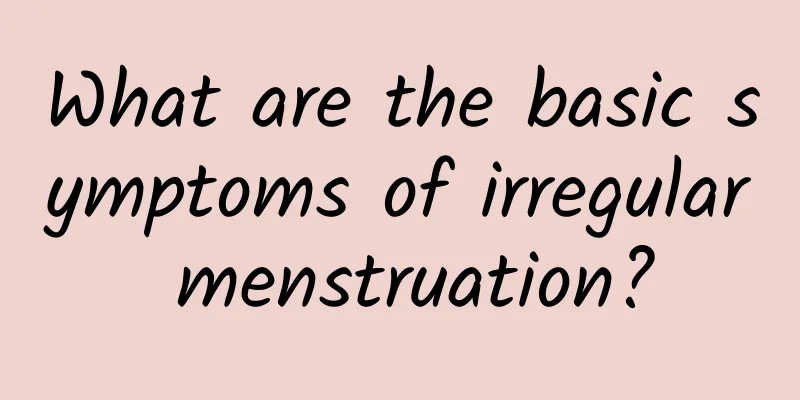What are the basic symptoms of irregular menstruation?

|
Menstrual disorders, also known as irregular menstruation, are a common gynecological disease. Irregular menstruation brings a lot of troubles to female friends, and also seriously affects the patient's physical and mental health. What are the basic symptoms of irregular menstruation? Let's ask experts to introduce some basic symptoms of irregular menstruation. Menstrual disorders are manifested as abnormal menstrual cycles or bleeding, or abdominal pain and systemic symptoms before menstruation. The cause may be organic disease or dysfunction. Blood disease, hypertension, liver disease, endocrine disease, miscarriage, ectopic pregnancy, hydatidiform mole, reproductive tract infection, tumors (such as ovarian tumors, uterine fibroids), etc. can all cause menstrual disorders. Basic symptoms of irregular menstruation: 1. Early menstruation Early menstruation refers to a shortened menstrual cycle that is shorter than 21 days and occurs for more than two consecutive cycles. It is a biphasic basal body temperature of ovulatory functional uterine bleeding, a short follicular phase of only 7 to 8 days, or a luteal phase of less than 10 days, or a temperature rise of less than 0.5°C. 2. Delayed menstruation: Menstruation is delayed for more than 7 days, or even 40 to 50 days, and occurs for more than two consecutive menstrual cycles. For those who ovulate, the basal body temperature is biphasic, but the follicular phase is long and the high temperature phase is low; for those who do not ovulate, the basal body temperature is monophasic. 3. Prolonged menstruation. The menstrual cycle is normal, but the menstrual period is prolonged, exceeding 7 days or even 2 weeks. Those with inflammation usually have lower abdominal pain, which is aggravated during menstruation. Usually, the amount of vaginal discharge is heavy, yellow or yellow-white, thick and smelly. Those with incomplete corpus luteum atrophy also have heavy menstrual flow; those with prolonged endometrial repair still have a small amount of continuous vaginal bleeding after the normal menstrual period. 4. Menstrual disorders include irregular menstruation, early or delayed menstruation, and a cycle that is shorter than 21 days or longer than 35 days. The above is an introduction to the basic symptoms of irregular menstruation. I hope everyone can pay attention to it. If you have symptoms of irregular menstruation, please go to the hospital in time to avoid delaying the condition and causing serious harm. If you have any questions about irregular menstruation, please consult our online experts for answers. I wish you a speedy recovery! Irregular menstruation http://www..com.cn/fuke/yjbt/ |
<<: What are the prevention methods for adnexitis?
>>: A brief discussion on the causes of irregular menstruation
Recommend
Can bacterial vaginosis be transmitted to other people?
In recent years, due to poor hygiene, the rate of...
What should I do if my period is delayed for 2 months?
What should I do if my period is delayed for 2 mo...
Nutrition without burden! DIY celery fried chicken light lunch box, only 400 calories
【Bento side dishes: Stir-fried chicken with celer...
What are the symptoms of vulvar leukoplakia
Vulvar leukoplakia is also known as vulvar leukop...
What are the complications of candidal vaginitis?
Regarding the complications of vaginitis, they us...
What is the likelihood that bacterial vaginosis will heal on its own?
When the patient's own disease resistance is ...
Build perfect abs! Just rely on supine punching exercise
【Supine punching exercise】 Number of exercises: 2...
How to prevent and treat cervical hypertrophy?
Many women have a certain degree of panic and don...
Is it normal to have fluid in the uterus before menstruation?
Whether it is normal to have uterine fluid accumu...
Can almonds cause miscarriage? What dietary taboos do pregnant women need to pay attention to?
Almonds are rich in nutritional value. The VE con...
How much is the cost of abortion?
Nowadays, many women who have unexpected pregnanc...
Does microwave treatment of cervical erosion affect fertility?
Does microwave treatment of cervical erosion affe...
What causes cervical hypertrophy?
What causes cervical hypertrophy? Experts say: Ce...
What happens if I haven’t had my period for three months?
What happens if I haven’t had my period for three...
Chinese New Year diet: adding, subtracting, multiplying and dividing broccoli to promote detoxification
During the Chinese New Year, many people have unl...









